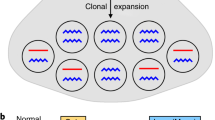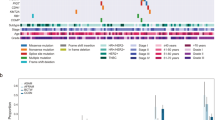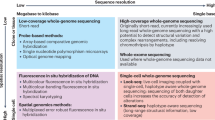Abstract
In breast cancer, loss of heterozygosity (LOH) has been described on the long arm of chromosome 7, at band q31, suggesting the presence of a tumor suppressor gene in this region. In this study, we have identified a second region of LOH on 7q, at band 7q22. Deletion of genetic material at 7q22 was found in all tumor types and grades and was associated with increased tumor size. The region of LOH at 7q22 in every case included one or more of three polymorphic markers that are located within the CUTL1 gene. LOH of 7q22 has also been documented in the case of human uterine leiomyomas (Zeng et al., 1997; Ishwad et al., 1997). Interestingly, in both leiomyomas and mammary tumors induced in transgenic mice expressing the Polyomavirus (PyV) large T (LT) antigen, immunocomplexes of CUTL1 and PyV LT antigen were detected (Webster et al., 1998). Altogether, genetic data in human breast cancer and biochemical analyses in breast tumors from transgenic mice suggest that CUTL1 is a candidate tumor suppressor gene.
This is a preview of subscription content, access via your institution
Access options
Subscribe to this journal
Receive 50 print issues and online access
$259.00 per year
only $5.18 per issue
Buy this article
- Purchase on Springer Link
- Instant access to full article PDF
Prices may be subject to local taxes which are calculated during checkout


Similar content being viewed by others
References
Andres V, Nadal-Ginard B and Mahdavi V. . 1992 Dev. 116: 321–334.
Berkerkarauzum S, Luleci G, Ozbilim G, Erdogan A, Kuzucu A et al. 1998 Cancer Gene. Cytogen. 100: 114–123.
Bièche I, Champeme MH, Matifas F, Hacene K, Callahan R et al. 1992 Lancet 339: 139–143.
Bièche I, Khodja A, Driouch K and Lidereau R. . 1997 Clin. Cancer Res. 3: 1009–1016.
Bièche I and Lidereau R. . 1995 Genes, Chrom. Cancer 14: 227–251.
Callahan R, Cropp C, Merlo GR, Diella F, Venesio T et al. 1993 Clinica Chimica Acta 217: 63–73.
Champeme MH, Bieche I, Beuzelin M and Lidereau R. . 1995 Genes Chrom. Cancer 12: 304–306.
Coqueret O, Bérubé G and Nepveu A. . 1998 EMBO J. 17: 4680–4694.
Dave BJ, Hopwood VL, King TM, Jiang H, Spitz MR et al. 1995 Cancer Epidem. Biomarkers Prev. 4: 743–749.
Deng G, Chen LC, Schott DR, Thor A, Bhargava V et al. 1994 Cancer Res. 54: 499–505.
Devilee P, Hermans J, Eyfjord J, Boorresen AL, Liderau R et al. 1997 Genes Chrom. Cancer 18: 193–199.
Dufort D and Nepveu A. . 1994 Mol. Cell. Biol. 14: 4251–4257.
Fischer K, Brown J, Scherer SW, Schramm P, Stewart J et al. 1998 Recent Res. Cancer Res. 144: 46–52.
Haber D and Harlow E. . 1997 Nature Genet. 16: 320–322.
Harada R, Dufort D, Denis-Larose C and Nepveu A. . 1994 J. Biol. Chem. 269: 2062–2067.
Harris JR, Lippman ME, Veronesi U and Willett W. . 1992 N. Engl. J. Med. 327: 319–328.
Ishwad CS, Ferrell RE, Hanley K, Davare J, Meloni AM et al. 1997 Genes Chrom. Cancer 19: 156–160.
Isobe M, Emanuel BS, Givol D, Oren M and Croce CM. . 1986 Nature 320: 84–85.
Kerangueven F, Noguchi T, Coulier F, Allione F, Wargniez V et al. 1997 Cancer Res. 57: 5469–5474.
Kristjansson AK, Eiriksdottir G, Ragnarsson G, Sigurdsson A, Gudmundsson J et al. 1997 Anticancer Res. 17: 93–98.
Larsson C, Bystrom C, Skoog L, Rotstein S and Nordenskjold M. . 1990 Genes Chrom. Cancer 2: 191–197.
Lin JC, Scherer SW, Tougas L, Traverso G, Tsui LC et al. 1996 Oncogene 13: 2001–2008.
Lundgren R. . 1991 Scand. J. Urol. Nephrol. 136: 1–35.
Lundgren R, Mandahl N, Heim S, Limon J, Henrikson H et al. 1992 Genes Chrom. Cancer 4: 16–24.
Mailly F, Berube G, Harada R, Mao PL, Phillips S et al. 1996 Mol. Cell. Biol. 16: 5346–5357.
Mann HB and Whitney DR. . 1947 Ann. Mathemat. Stat. 18: 50–60.
McBride OW, Merry D and Givol D. . 1986 Proc. Natl. Acad. Sci. USA 83: 130–134.
Mertens F, Johansson B, Hoglund M and Mitelman F. . 1997 Cancer Res. 57: 2765–2780.
Miki Y, Swensen J, Shattuck-Eidens D, Futreal PA, Harshman K et al. 1994 Science 266: 66–71.
Miller C, Mohandas T, Wolf D, Prokocimer M, Rotter V et al. 1986 Nature 319: 783–784.
Neufeld EJ, Skalnik DG, Lievens PM and Orkin SH. . 1992 Nature Genet. 1: 50–55.
Ozïsik YY, Meloni AM, Surti U and Sandberg AA. . 1993 Cancer Genetics & Cytogenetics 71: 1–6.
Quaggin SE, Vandenheuvel GB, Golden K, Bodmer R and Igarashi P. . 1996 J. Biol. Chem. 271: 22624–22634.
Sargent MS, Weremowicz S, Rein MS and Morton CC. . 1994 Cancer Genetics & Cytogenetics 77: 65–68.
Sato T, Tanigami A, Yamakawa K, Akiyama F, Kasumi F et al. 1990 Cancer Res. 50: 7184–7189.
Skalnik DG, Strauss EC and Orkin SH. . 1991 J. Biol. Chem. 266: 16736–16744.
Solinas-Toldo S, Wallrapp C, Muller-Pillasch F, Bentz M, Gress T et al. 1996 Cancer Res. 56: 3803–3807.
Storto PD, Saidman SL, Demetris AJ, Letessier E, Whiteside TL et al. 1990 Genes Chrom. Cancer 2: 300–310.
Tougas L, Halwani F, Tremblay G, Sampalis J, Lin J et al. 1996 Clin. Investig. Med.–Medecine Clinique et Experimentale 19: 222–230.
Valarche I, Tissier-Seta JP, Hirsch MR, Martinez S, Goridis C et al. 1993 Development 119: 881–896.
Watson PH, Safneck JR, Le K, Dubik D and Shiu RP. . 1993 J. Natl. Cancer Inst. 85: 902–907.
Watson PH, Snell L and Parisien M. . 1996 Cmaj 155: 281–283.
Webster MA, Martinsoudant N, Nepveu A, Cardiff RD and Muller WJ. . 1998 Oncogene 16: 1963–1972.
Wooster R, Bignell G, Lancaster J, Swift S, Seal S et al. 1995 Nature 378: 789–792.
Xing YP, Powell WL and Morton CC. . 1997 Cancer Genetics & Cytogenetics 98: 69–74.
Yoon SO and Chikaraishi DM. . 1994 J. Biol. Chem. 269: 18453–18462.
Zeng WR, Scherer SW, Koutsilieris M, Huizenga JJ, Filteau F et al. 1997 Oncogene 14: 2355–2365.
Zenklusen JC, Bieche I, Lidereau R and Conti CJ. . 1994 Proc. Natl. Acad. Sci. USA 91: 12155–12158.
Acknowledgements
We are grateful to Drs Irene Andrulis and Ivan Bièche for allowing us to use samples collected respectively at the Mount Sinai Hospital in Toronto, Canada and the Centre René Huguenin, Saint-Cloud, France. Thanks are also due to Jo-Ann Bader for advice on deparaffinization, and Lam Leduy for the mapping of polymorphic markers and processing the tumors used in this study. This research was funded by an operating grant to AN from the US Army Medical Research and Materiel Command (USAMRMC) as part of the Breast Cancer Research Program (BCRP). AN is the recipient of a scholarship from Le Fonds de la Recherche en Santé du Québec. WRZ is the recipient of studentships from the Alexander McFee Studentship, the McGill University Department of Medicine Internal Studentship, and the Research Institute of the Royal Victoria Hospital Studentship.
Author information
Authors and Affiliations
Rights and permissions
About this article
Cite this article
Zeng, W., Watson, P., Lin, J. et al. Refined mapping of the region of loss of heterozygosity on the long arm of chromosome 7 in human breast cancer defines the location of a second tumor suppressor gene at 7q22 in the region of the CUTL1 gene. Oncogene 18, 2015–2021 (1999). https://doi.org/10.1038/sj.onc.1202519
Received:
Revised:
Accepted:
Published:
Issue Date:
DOI: https://doi.org/10.1038/sj.onc.1202519
Keywords
This article is cited by
-
Germline large genomic alterations on 7q in patients with multiple primary cancers
Scientific Reports (2017)
-
−7/7q− syndrome in myeloid-lineage hematopoietic malignancies: attempts to understand this complex disease entity
Oncogene (2015)
-
CUX1, a haploinsufficient tumour suppressor gene overexpressed in advanced cancers
Nature Reviews Cancer (2014)
-
Induction of acetylcholinesterase expression during apoptosis in various cell types
Cell Death & Differentiation (2002)



